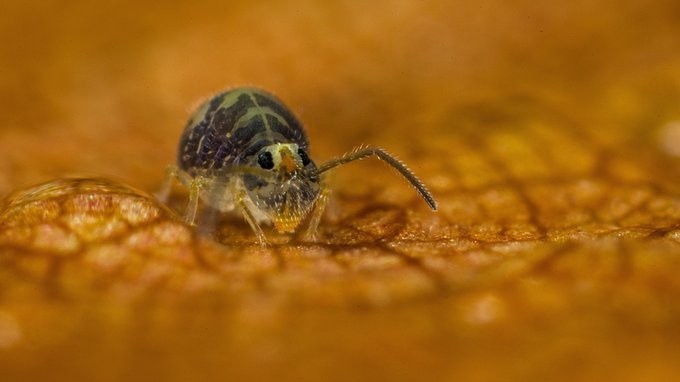Among the wonders of the natural world
that few people have ever noticed: a semiaquatic springtail in motion.
There are around 9,000 known species of springtails
— small flea-like invertebrates — around the world. Many live in dark, humid
habitats, but they can be found on all seven continents; some even migrate over
snow. The arthropods rove the Earth by flinging their bodies into the air,
sometimes rotating 500 times per second, like circus performers shot out of
self-contained canons. But good luck getting a look at their trapeze show —
most springtails are “as small as a grain of sand”, said Víctor Ortega Jiménez,
a biomechanics researcher at the University of Maine who has studied the
creatures.
اضافة اعلان
Now, a series of slowed down, zoomed-in videos of
these high-octane jumps, released by Ortega Jiménez and colleagues in an
article published Monday in the journal Proceedings of the
National Academy of Sciences, reveals an element of tiny bodily control that is almost graceful.
The visuals aid a detailed explanation of how springtails jump through the air
and end up on their feet nearly every time they land.
Ortega Jiménez said the springtails’ control largely
came from their most distinctive and enigmatic feature, the collophore, a tube
sticking out of their abdomens. This tube interacts in nuanced ways with the
forces around the animals: drag, surface tension, gravity. “They are taking
advantage of the water and the air,” Ortega Jiménez said.
Springtails are not insects, although they were
classified that way for a long time because of their six legs, segmented
bodies, and antennae. Because of their mouths, which are retracted inside their
heads, they now make up the majority of a different taxonomic class:
entognatha.
Taxonomically, springtails are called Collembola, a
label given to them by John Lubbock, an English polymath of the 19th and early
20th centuries. The word comes from the Greek words for “glue” and “peg”.
Lubbock chose the name from the behavior he observed after he flipped
springtails onto their backs and hovered a piece of glass above their stomachs.
The animals would reach for the shard with their legs while simultaneously
emitting a fluid from the tips of their collophores and pushing it toward the
surface. This fluid, Lubbock wrote, “no doubt, gives a better hold”.
Other scientists later disputed this explanation of
the collophore’s function. In the 20th century, the most widely accepted
functional explanation for the collophore — the only part of the springtail’s
body that attracts water — was as a way to suck up nutrients. Other uses were
proposed in the 21st century: It could be a self-cleaning tool or a way to
direct the springtail’s jump.

Ortega Jiménez, whose research focuses on how
animals move, became interested in springtails when he saw them hopping around
near a stream. While it was thought that the animals could only point
themselves in a direction and then flip wildly through the air, when the
arthropods jumped from the bank into water and back, Ortega Jiménez noticed
that they seemed to land exactly where they had started. Doing so would require
some kind of control throughout the entire jump.
Heading back to the lab, Ortega Jiménez started
filming springtails in flight, and he designed a small wind tunnel to see how
the animals dealt with different aerial conditions. He found that a
springtail’s collophore was involved in all parts of the jump.
During the takeoff, when the springtails smacked
their tail-like furculae off the water, the collophores picked up a drop of
water. As the animals spun around through the air, they curved their bodies
into a U shape, which slowed their spinning and eventually allowed them to fly
through the air straight, like mini superheroes.
When flipped upside down while in the wind tunnel,
springtails with water droplets on their collophores were able to flip
themselves around in less than 20 milliseconds, faster than any animal
previously recorded. Chests out, the springtails landed, and the watery
collophore gave them a more stable base and a sticky adherence to the surface.
“They were skydiving, and they were landing on their
feet,” Ortega Jiménez said.
Using mathematical models, the researchers found
that springtails with water droplets on their collophores flopped around much
less when they landed than dry springtails; they could end up on their feet in
half the time. Saad Bhamla, a biomechanics researcher at the Georgia Institute
of Technology who also worked on the research, said that, though there were
probably other functions of the collophore, its role in jumping — during
takeoff, flight, and landing — seemed to be crucial. “That, to me, is the
fantastic feature here,” he said.
Bhamla helped to bring in roboticists, who designed
a robot based on the springtail that could right itself in the air and land on
its feet 75 percent of the time. This kind of control, he said, has been
understudied in robotics, which is often focused on the takeoff. Building a
machine that can consistently land on its feet means building a machine that
can be ready to jump sooner. “Because if they can control the jump, then they
can keep doing it again and again,” Bhamla said. “And that’s so much more
interesting.”
This, Ortega
Jiménez said, could also offer an evolutionary explanation to the springtails’
jumps. While there is much speculation at this point and “the evolution of
these jumping animals is a mystery”, a quick recovery from a jump allows the
springtails to better escape from predators. “Being ready is essential for
survival,” Ortega Jiménez said.
It surprised the researchers to find so much control
in such tiny animals. But dynamics on small scales are often counterintuitive,
and even basic features can be easily overlooked. A little bit of water on the
abdomen can change everything.
“Design motif-wise, it’s so ridiculously simple,” Bhamla
said. “It’s, like, ‘Why didn’t I think of this?’”
Read more Odd and Bizarre
Jordan News



